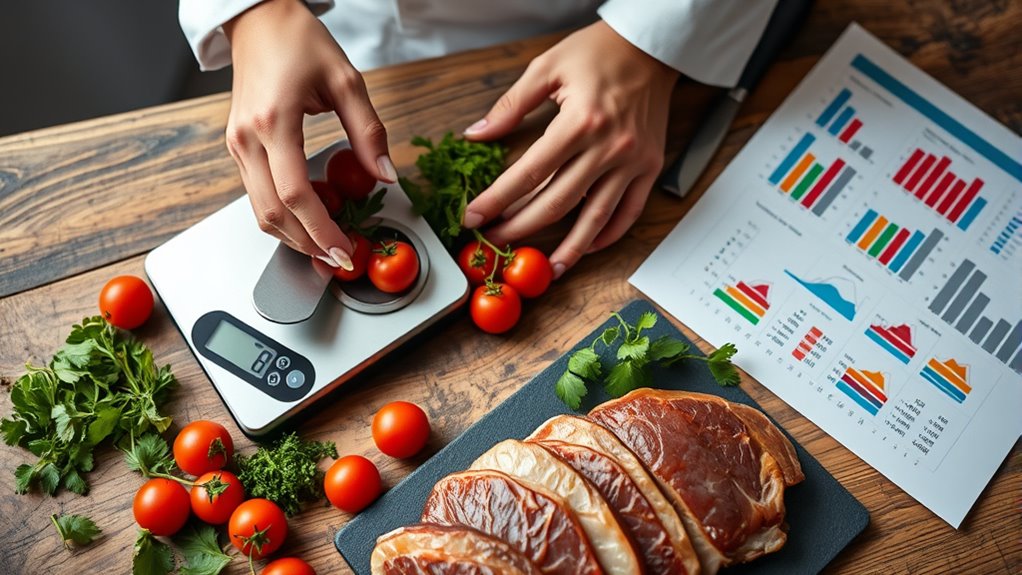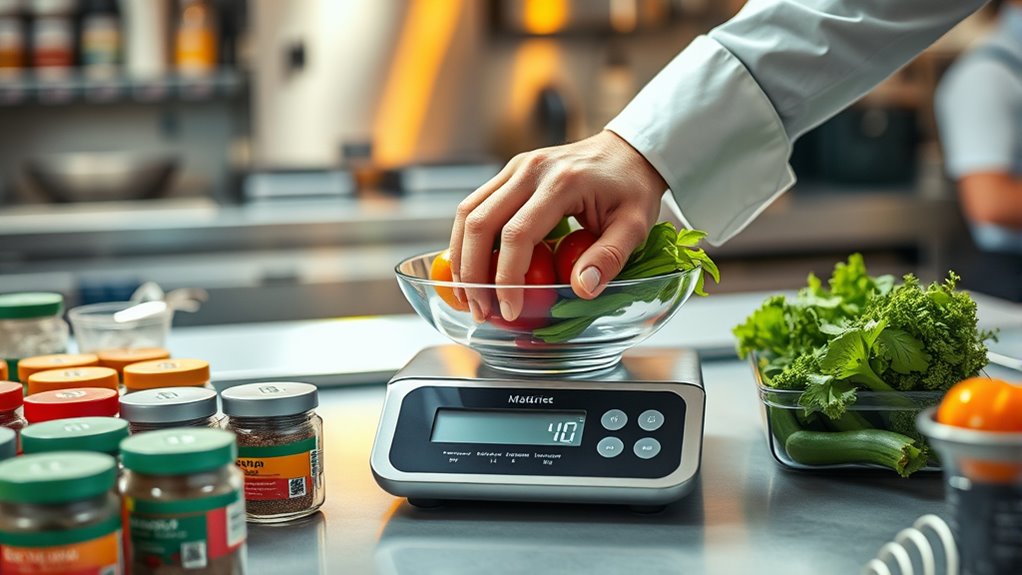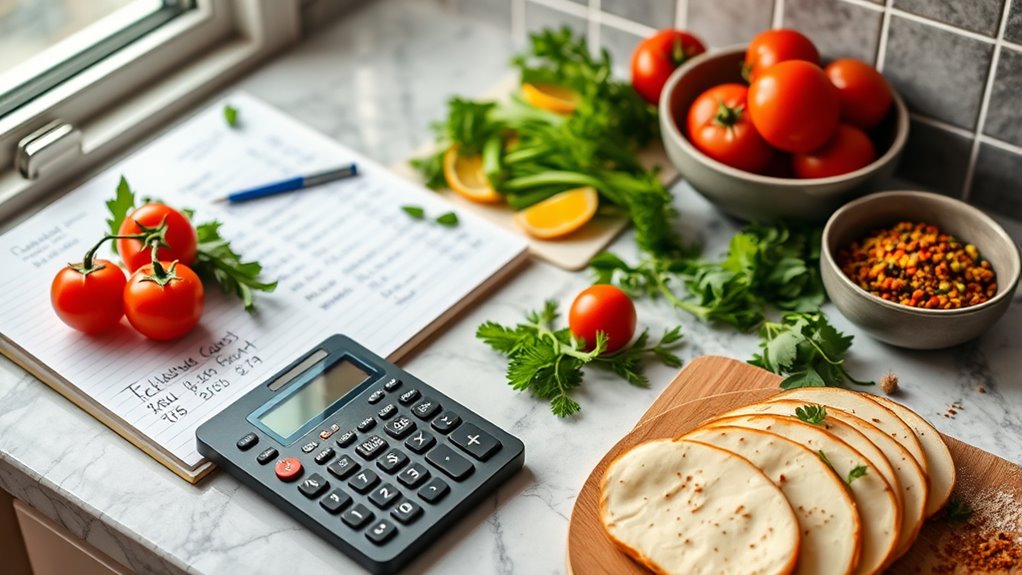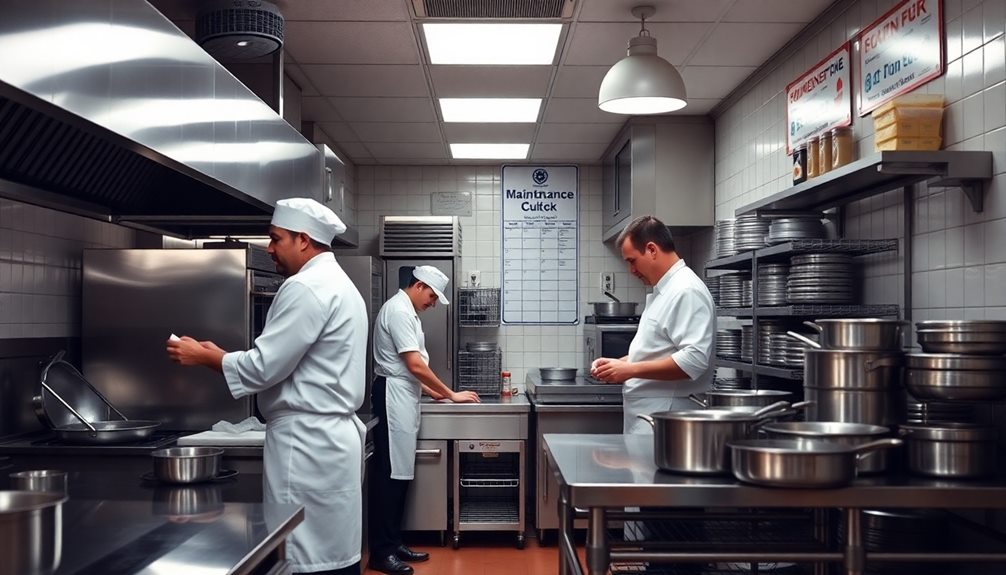To calculate your food-cost percentage accurately, track all food purchases, waste, and spoilage regularly. Sum your total food costs—including theft and over-portioning—and divide that by your total food sales for the same period. Multiply the result by 100 to get the percentage. Remember to adjust your calculations for waste and shrinkage to reflect true costs. Keep these details consistent over the same time frame, and you’ll master precise food-cost calculations. If you want to know more, stay tuned.
Key Takeaways
- Track all food inventory purchases, usage, waste, and spoilage precisely to ensure accurate cost calculations.
- Calculate total food costs by including ingredients, waste, shrinkage, and theft for a true expense measure.
- Divide total food costs by total food sales for the period, then multiply by 100 to determine the percentage.
- Adjust ingredient costs to account for waste and shrinkage, ensuring costs reflect actual usage.
- Use consistent time frames for sales and inventory data to enable reliable trend analysis and accurate percentage calculation.
Understanding the Components of Food Cost

Understanding the components of food cost is essential for managing your restaurant’s expenses effectively. When you break down food cost, you’re looking at the direct expenses involved in preparing your menu items. The main components include raw ingredients, beverages, and garnishes. You also need to account for portion sizes, waste, and spoilage, which can silently inflate costs if not monitored. Purchasing costs are influenced by supplier prices, bulk buying discounts, and order accuracy. Keep track of inventory levels and usage to identify any discrepancies. By understanding these elements, you gain better control over your purchasing decisions and menu pricing. This clarity helps you reduce waste, optimize stock levels, and improve profitability without sacrificing quality. Additionally, understanding Ice Cream Recipes can inspire creative menu options that appeal to customers and potentially increase sales.
Calculating Total Food Costs Correctly
Calculating total food costs accurately is crucial for maintaining profitable restaurant operations. To do this effectively, you need to:
Accurate food cost calculation is key to profitable restaurant management.
- Track all food inventory purchases precisely.
- Record usage and waste consistently.
- Account for spoilage, theft, and over-portioning.
- Regularly review your inventory records to ensure they reflect actual stock levels.
Start by adding up the cost of all ingredients purchased within a specific period. Subtract any leftover inventory at the end of that period to determine the actual food used. Include costs from spoilage, waste, and theft to guarantee accuracy. Regularly reconcile your inventory records with actual stock to identify discrepancies. Accurate calculations prevent underestimating costs, helping you set appropriate menu prices and control expenses. By paying close attention to these details, you’ll gain a clear picture of your true food costs, essential for calculating profit margins and making informed business decisions.
Determining Total Revenue From Food Sales

To determine your total revenue from food sales, start by adding up all sales amounts. Make sure to track different payment methods and record sales over specific time periods to get an accurate picture. This clear overview helps you understand your revenue flow and set better financial goals. Monitoring sales trends related to your food offerings can also help you identify high-performing items and adjust your menu accordingly.
Summing Food Sales
Have you ever wondered how restaurants determine their total revenue from food sales? To find this, you need to sum all sales accurately. Here’s how you do it:
- Collect daily sales reports from your POS system.
- Verify all menu items are correctly recorded and priced.
- Add up the sales from each shift or day to get a total.
- Consider sales tracking tools that can help automate and ensure accuracy in this process.
Tracking Payment Methods
Ever wonder how restaurants accurately track their total food revenue? It all starts with recording each payment method used. You need to identify all ways customers pay—cash, credit cards, mobile payments, and gift cards. By systematically recording each transaction, you ensure no sales are missed. Use your point-of-sale system to categorize and sum payments by method, making reconciliation easier. Regularly verify that the total from all payment methods aligns with your sales reports. This helps catch discrepancies quickly and keeps your revenue data precise. Tracking payment methods also reveals customer preferences, which can inform your sales strategies. Incorporating industry trends into your tracking process can give you a competitive edge. Ultimately, accurately capturing every payment guarantees you determine your total food revenue correctly, forming the foundation for calculating your food-cost percentage with confidence.
Recording Revenue Timelines
Understanding the timeline of your food sales is essential for accurately determining your total revenue. To do this effectively, you need to track when transactions occur and compile data accordingly. Focus on these key steps:
- Record daily sales totals to identify patterns or fluctuations.
- Track sales by different time segments—morning, afternoon, evening—to understand peak hours.
- Consolidate weekly and monthly summaries for an all-encompassing view of revenue trends.
- Be aware of Cookies and privacy settings that may affect how you collect and analyze sales data for compliance and accuracy.
Using the Correct Time Frame for Your Calculations

Choosing the right time frame for your calculations helps you track progress effectively. Make certain your periods align with your goals to get accurate insights. Consistent time frames prevent data mismatch and ensure reliable comparisons over time. Incorporating diverse beach experiences can help you understand seasonal variations and preferences more thoroughly.
Aligning Periods With Goals
To make certain your food-cost percentage calculations are meaningful, it’s vital to match your time frame with your specific goals. First, identify whether you’re tracking daily, weekly, or monthly performance, as each serves different purposes. Second, consider your sales cycle; aligning periods with busy or slow seasons provides more accurate insights. Third, set goals based on your operational rhythm—if you’re launching new menu items, shorter periods help monitor immediate impact. Using consistent time frames ensures comparability over periods, while mismatched periods can distort trends. Additionally, incorporating relationship principles can facilitate better communication and understanding among team members regarding cost management. By selecting the appropriate timeframe, you gain clearer visibility into cost fluctuations, enabling more informed decisions that support your financial targets. Proper alignment keeps your calculations relevant and actionable, helping you manage food costs effectively.
Consistency in Timeframes
Using the correct time frame for your calculations is essential to accurately assess your food-cost percentage. If you compare weekly sales to monthly purchases, your numbers won’t reflect true costs, leading to misinformed decisions. Consistency guarantees comparability over time. Decide whether you’ll analyze daily, weekly, or monthly data, and stick with it. This methodology helps identify trends and track improvements accurately.
Avoiding Data Mismatch
Ensuring you select the correct time frame for your calculations prevents data mismatch, which can lead to inaccurate food-cost percentage analysis. If your data covers different periods, your results won’t reflect true costs. To avoid this, focus on these key points:
- Use the same time frame for both sales and inventory data.
- Align purchase dates with sales periods to capture accurate costs.
- Regularly update your calculations to reflect current operations.
- Incorporate knowledge of inventory management techniques, such as self watering plant pots, to understand how timing can affect resource availability and cost tracking.
Applying the Food-Cost Percentage Formula

Applying the food-cost percentage formula involves straightforward calculations that help you manage your food expenses effectively. To do this, divide your total food costs for a specific period by your total food sales during the same time. Then, multiply the result by 100 to get the percentage. For example, if your food costs are $2,000 and your sales are $10,000, the calculation is ($2,000 / $10,000) x 100, which equals 20%. This percentage shows how much of your sales revenue is spent on food. Regularly applying this formula allows you to monitor trends, identify areas where costs are rising, and make informed decisions to improve profitability. Keep your calculations consistent for accurate comparisons and better control over your food expenses.
Adjusting for Waste and Shrinkage in Costs

Since waste and shrinkage can significantly impact your actual food costs, it’s essential to adjust your calculations accordingly. Ignoring these factors can lead to underestimating true costs and skewing your food-cost percentage. To account for waste and shrinkage, consider these steps:
- Track waste consistently during food prep and service to identify patterns.
- Calculate shrinkage rates for each ingredient by comparing purchases to usage.
- Adjust your total ingredient costs by the identified shrinkage percentages to reflect real expenses.
Using Food-Cost Percentage to Inform Pricing and Inventory Decisions

Understanding your food-cost percentage helps you make smarter pricing and inventory decisions. When you know your percentage, you can set menu prices that ensure profitability without overcharging customers. It also guides inventory management—by tracking waste and adjusting orders accordingly. Use the table below to see how different food-cost percentages impact your decisions:
| Food-Cost % | Suggested Markup | Inventory Focus |
|---|---|---|
| 25% | 3x cost | Minimize waste |
| 30% | 2.7x cost | Monitor portion sizes |
| 35% | 2.5x cost | Optimize supplier orders |
Keeping these figures in mind helps you balance profitability with customer satisfaction, ensuring your business remains sustainable.
Frequently Asked Questions
How Often Should I Review My Food-Cost Percentage?
You should review your food-cost percentage regularly to keep costs in check. Ideally, do this weekly or bi-weekly, especially during busy seasons or when menu changes occur. Consistent monitoring helps you spot discrepancies early and adjust pricing or portions as needed. Don’t wait too long—monthly reviews can also work if your operations are steady. Staying proactive guarantees your margins stay healthy and your business stays profitable.
Can Food-Cost Percentage Vary by Cuisine Type?
Think of your menu as a colorful tapestry—different cuisines bring unique ingredients and costs. Yes, your food-cost percentage can vary by cuisine type because some dishes require pricier ingredients or more complex preparation. For example, seafood dishes might have higher costs than vegetarian options. Adjust your calculations accordingly, and keep an eye on these differences to maintain profitability and guarantee your prices reflect the true costs of each cuisine.
What Software Tools Can Help Automate These Calculations?
You can use software tools like Toast, Square for Restaurants, or MarketMan to automate food-cost percentage calculations. These platforms integrate sales data and inventory costs, providing real-time insights and reducing manual errors. By using such tools, you save time and guarantee accuracy, making it easier to monitor your food costs and adjust pricing strategies seamlessly. These solutions are user-friendly and designed to help you manage costs efficiently.
How Do Seasonal Menu Changes Impact Food-Cost Percentage?
Seasonal menu changes can greatly impact your food-cost percentage. When you switch ingredients or dishes based on seasonality, costs fluctuate due to ingredient availability and pricing. You need to regularly track these variations and adjust your pricing or portion sizes to maintain profitability. By staying aware of seasonal trends, you can better manage costs, avoid over-spending, and ensure your menu remains profitable throughout the year.
What Are Common Mistakes to Avoid in Food-Cost Calculations?
When you’re calculating food-cost percentage, avoid common mistakes like using inconsistent data, forgetting to include all ingredient costs, or neglecting portion sizes. Don’t rely solely on invoice totals; double-check unit costs and waste. Make certain to update your calculations regularly to reflect seasonal changes and menu updates. By paying close attention to detail and maintaining consistency, you guarantee your food-cost percentage remains accurate and helps you control expenses effectively.
Conclusion
By paying close attention to each component of your food costs and using the right calculations, you can gently steer your business toward better profitability. Remember, small adjustments and mindful tracking can make a big difference over time. Keep refining your approach, and you’ll find the perfect balance that keeps your customers happy and your bottom line healthy. With a little patience, your food-cost management will become second nature, leading to steady growth and success.









